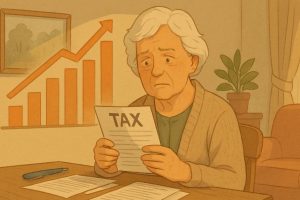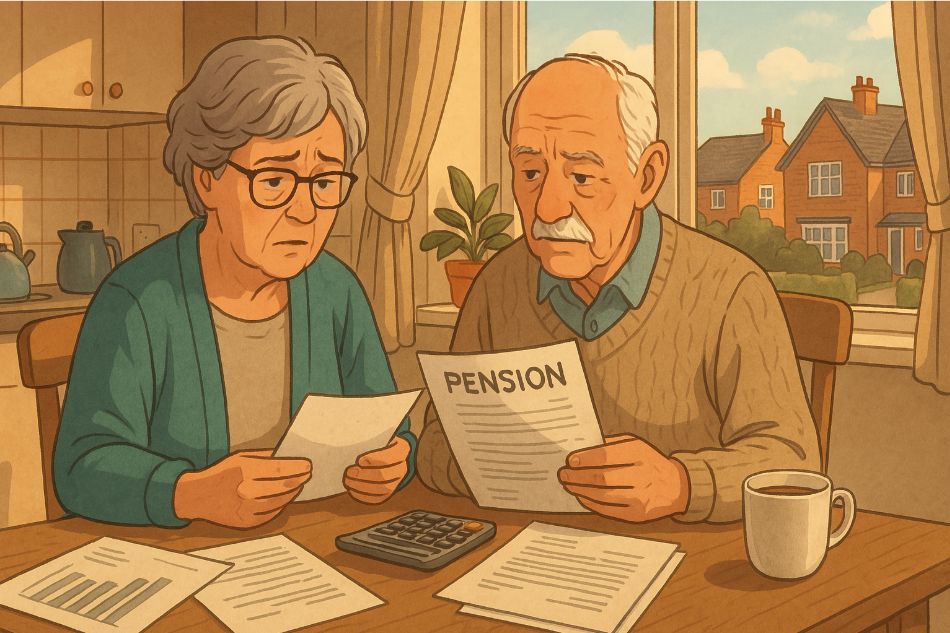The UK tax system is often complex, but for pensioners, 2025 brings new challenges that are subtle yet significant. While tax rates and allowances might appear unchanged on paper, many retirees will find themselves paying more income tax this year than ever before.
This is primarily due to the combination of frozen tax thresholds, rising State Pensions, and fiscal drag a phenomenon where inflationary increases in income push individuals into higher tax bands, even if their real purchasing power hasn’t improved.
In this blog, we provide a comprehensive and up-to-date overview of how the pensioner income tax increase will impact individuals in retirement across the UK in 2025, and what steps can be taken to understand and manage this evolving financial reality.
What Are the New Tax Rules for Pensioners in 2025?

While there have been no sweeping overhauls to the pension tax system in 2025, existing rules are having a more noticeable impact due to changing financial conditions. The personal allowance the threshold under which no income tax is paid remains frozen at £12,570 for the 2025/26 tax year.
Despite the lack of change to rates and bands, the economic landscape has shifted. Incomes, especially the State Pension, are increasing due to inflation and the government’s continued commitment to the triple lock. Meanwhile, the basic income tax bands remain fixed at 20%, 40%, and 45%. This misalignment between static thresholds and rising incomes is drawing more pensioners into the tax paying population.
The abolition of the Lifetime Allowance also took effect, replaced by two new measures: the Lump Sum Allowance of £268,275, and the Lump Sum and Death Benefit Allowance of £1,073,100. While these affect those with larger pension pots, they represent a significant shift in pension taxation.
What Is the Current Tax Allowance for Pensioners in the UK?
The personal allowance has become a central concern for pensioners. It currently stands at £12,570, and this amount has been frozen since 2021. The government has stated this will remain unchanged until at least 2028.
This is particularly important for pensioners as their incomes, especially from the State Pension, are increasing year on year. As a result, the real-world effect is a growing number of retirees exceeding the tax-free threshold, even if they consider their overall income to be modest.
This situation is exacerbated by the fact that the UK no longer offers a higher personal allowance for those over a certain age a measure that was phased out several years ago. Therefore, a pensioner is treated in exactly the same way as any working-age adult when it comes to income tax liability.
How Much Income Tax Do Pensioners Pay in 2025?
The exact amount of tax a pensioner pays depends entirely on their total taxable income. This includes the State Pension, any private or workplace pensions, and potentially other income such as savings interest, rental income, or part-time work.
Understanding the Tax Bands
The income tax bands in 2025/26 are as follows:
- Personal Allowance: Income up to £12,570 – 0% tax
- Basic Rate: Income from £12,571 to £50,270 – taxed at 20%
- Higher Rate: Income from £50,271 to £125,140 – taxed at 40%
- Additional Rate: Income over £125,140 – taxed at 45%
Let’s consider a simple example. A full new State Pension in 2025 is estimated at £11,542 annually following a 4.1% increase. That leaves a margin of only about £1,028 before any additional income such as a small private pension becomes taxable. If you receive £15,000 in total pension income, approximately £2,430 would be taxable, resulting in an income tax bill of about £486.
Why Will Pensioners Pay More Tax in 2025?

At first glance, it might appear that pensioners are not being actively targeted for higher taxes. However, the policy of freezing the personal allowance and other tax bands until 2028 means that any increases in income even modest ones driven by inflation push people over tax thresholds. This is known as fiscal drag.
The Effect of Rising Pensions
The triple lock, which guarantees that the State Pension rises by the highest of inflation, average earnings growth, or 2.5%, has contributed to an uplift in pension income. For 2025, the State Pension rose by 4.1%, bringing many pensioners’ total income dangerously close to or even above the personal allowance.
As a result, retirees who might not have paid tax in previous years are now seeing deductions from their pension or receiving demands from HMRC for underpaid tax.
How Will the Personal Allowance Freeze Affect Pensioners’ Tax Bills?
The freeze on the personal allowance is one of the most significant contributors to higher tax bills for pensioners. In prior decades, the personal allowance typically increased with inflation. By holding it steady while incomes rise, the government collects more tax without technically raising tax rates.
This has a pronounced effect on pensioners because many of them are on fixed incomes and have limited flexibility. A pensioner earning £13,500 in 2025 will now pay tax on £930 of their income which wouldn’t have been taxable if the personal allowance had risen with inflation.
In this sense, the personal allowance freeze functions as a stealth tax, and its effects are particularly acute for retirees.
Is the State Pension Now Pushing Pensioners into the Tax Bracket?
Yes, the growth of the State Pension due to the triple lock means that it alone is almost sufficient to push someone into the tax net. With the new full State Pension at £221.20 per week (or roughly £11,542 annually), a pensioner with any additional income at allwhether from a private pension or interest on savings can easily cross the £12,570 threshold.
This is a significant change from just a few years ago, when the State Pension was comfortably below the personal allowance and allowed retirees to earn a modest supplement without owing tax.
What Are the New Income Tax Thresholds for Pensioners in 2025?
While the tax bands have not changed, it’s essential to restate them clearly to understand their effects:
| Tax Band | Income Range | Tax Rate |
| Personal Allowance | Up to £12,570 | 0% |
| Basic Rate | £12,571 – £50,270 | 20% |
| Higher Rate | £50,271 – £125,140 | 40% |
| Additional Rate | Over £125,140 | 45% |
These thresholds apply regardless of age, and there are no special concessions for those over retirement age.
Can Pensioners Minimise Their Tax Liability Legally?

Pensioners can explore several strategies to help manage or reduce their tax obligations. While not all options will be suitable for everyone, many retirees could benefit from a personalised tax review.
Using ISAs and Tax-Free Allowances
Investing in Individual Savings Accounts (ISAs) is a common method for generating income that is entirely tax-free. Even after retirement, ISAs remain a useful tool for minimising taxable income.
Managing Pension Withdrawals
By staggering pension withdrawals, pensioners can stay under the basic rate threshold or avoid triggering tax in years when income from other sources is higher.
Exploring the Marriage Allowance
If one spouse earns below the personal allowance and the other earns modestly above it, they may be eligible to transfer part of the unused allowance under the Marriage Allowance, potentially saving up to £252 a year.
Are Older or Low-Income Pensioners Eligible for Tax Relief or Exemptions?
While the tax system itself does not offer age-based exemptions, low-income pensioners may qualify for government support schemes that help reduce overall financial pressure.
Pension Credit and Other Benefits
Pension Credit remains a valuable resource for low-income pensioners, supplementing their income to a minimum level. In addition, programs such as the Winter Fuel Payment, Warm Home Discount, and Council Tax Reduction provide further relief especially important during periods of high energy costs.
What Do Financial Experts Say About Pensioner Tax Increases?
Tax experts and financial institutions have voiced concerns over the increasing tax burden on pensioners. Organisations such as the Institute for Fiscal Studies have highlighted how the freeze in allowances amounts to a significant real-term tax rise, disproportionately affecting those with fixed incomes.
Others, including Money Saving Expert, have pointed out that these changes are often poorly communicated, leaving many pensioners unaware until they are unexpectedly taxed.
What Is the Long-Term Outlook for Pensioner Taxation in the UK?

Looking forward, it appears the freeze on thresholds will continue until at least 2028. This suggests that the trend of more pensioners being drawn into taxation will also continue unless the policy is revised.
As a result, many financial advisors are urging pensioners to seek personalised financial planning and stay vigilant with tax updates each year to avoid surprises.
How Does HMRC Handle Pensioner Tax in 2025?
For many pensioners, the most confusing part of dealing with tax is understanding how HMRC applies it. especially when receiving income from multiple sources like a State Pension, a private pension, or savings. In 2025, HMRC has introduced improvements to simplify how pensioners are taxed, but certain complexities still exist.
Automatic Tax Code Adjustments
In 2025, HMRC automatically updates tax codes for most pensioners receiving new private pensions. This ensures taxes are deducted accurately through PAYE. While this system works well for many, it’s still important to check your code. Mistakes can lead to overpayments or underpayments that go unnoticed.
Multiple Income Sources: How It’s Prioritised
When pensioners receive income from more than one source, HMRC typically assigns the personal allowance to the largest PAYE income. The State Pension is paid gross, meaning untaxed. If not managed correctly, this setup can leave pensioners with unexpected tax bills. Regular reviews are essential.
Keeping Your Tax Code Accurate
Your tax code determines how much tax is taken from your pension. If your income or circumstances change, it may need updating. Pensioners can check and update their code via GOV.UK or by calling HMRC. Doing so prevents errors that could impact your retirement finances.
Conclusion
The 2025 pensioner income tax increase may not involve new rates, but its impact is undeniable. Frozen allowances, rising State Pensions, and fiscal drag are quietly drawing more retirees into the tax net. Understanding your income sources and how HMRC applies tax can help avoid surprises.
With careful planning and regular checks, pensioners can manage their liabilities effectively. Staying informed is the key to protecting your retirement income in a changing tax landscape.
FAQs About Pensioner Income Tax Increase in the UK
Will pensioners pay more tax in 2025 even if their income hasn’t increased?
Yes. Due to frozen tax thresholds and rising pensions, many retirees are now exceeding the tax-free allowance even without receiving more money in real terms.
Is the triple lock on pensions contributing to the tax increase?
It plays a role, as the State Pension increases via the triple lock are now large enough to edge many retirees into taxable territory.
How does the tax affect those receiving both a private and state pension?
Both pensions are combined to calculate total income. If the combined amount exceeds £12,570, the pensioner will owe tax at 20% on the amount above the threshold.
Are low-income pensioners still protected from paying tax?
Only if their total income stays below £12,570. However, that’s becoming increasingly rare due to the State Pension increase.
Can pensioners claim any new benefits to offset the tax rise?
No new benefits have been introduced specifically to counteract the tax rise, but existing programs like Pension Credit remain available.
Do pensioners need to file a tax return in 2025?
In most cases, HMRC automatically adjusts tax codes, especially for those receiving pensions through PAYE. However, some may still need to file if they have multiple income sources.
What resources are available to help pensioners understand their tax obligations?
Reliable help can be found through HMRC, Citizens Advice, or consulting with a certified financial advisor.









Leave feedback about this